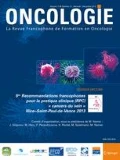Abstract
Head and neck carcinomas are serious diseases for which surgery is the main treatment. In roughly two thirds of cases, diagnosis is made at an advanced stage, which prevents optimal surgical resection. In this frequently occurring situation, the treatment usually recommended was a combination of radiotherapy and platinum-based chemotherapy. Several phase III trials have recently assessed an induction chemotherapy with platinum, docetaxel and 5 fluorouracil (TPF) followed by either radiotherapy or radiochemotherapy. These trials show an overall survival rate after induction chemotherapy equal or superior to conventional radiochemotherapy. The meaning of these studies is limited by several factors: a non-optimal comparison arm, patient selection depending on a good PS and the real TPF toxicity in non-selected patients. The use of induction chemotherapy must be conditional on cautious thorough evaluation after multidisciplinary discussion based on pros and cons. The latter will be discussed herein.
Résumé
Les carcinomes épidermoïdes de la tête et du cou sont des affections graves dont le traitement repose sur l’exérèse chirurgicale. Dans près de deux tiers des cas, le diagnostic de la maladie est réalisé à un stade avancé qui rend impossible la résection tumorale de facçon carcinologiquement satisfaisante. Dans cette situation fréquente, le traitement de référence reposait sur l’association de radiothérapie et de chimiothérapie concomitante à base de sels de platine. Récemment, plusieurs essais de phase III ont évalué un traitement d’induction par cisplatine, docétaxel et 5-fluoro-uracile (TPF) suivi d’une radiothérapie ou d’une radiochimiothérapie. Ces essais retrouvent des taux de survie, après chimiothérapie d’induction, comparables ou supérieurs à une radiochimiothérapie conventionnelle. Les limites de ces travaux sont le choix d’un bras de référence non optimal, la sursélection de patients en bon état général et la toxicité réelle du TPF chez des patients non sélectionnés. Les indications d’une chimiothérapie d’induction doivent être évaluées avec précaution et discussion pluridisciplinaire à la lumière du bénéfice risque. Ce sont ces avantages et inconvénients que nous nous proposons d’évaluer ici.
Similar content being viewed by others
Références
Argiris E, Gibson M, Heron R, et al. (2008) Cetuximab (C) and bevacizumab (B) in patients with recurrent or metastatic head and neck squamous-cell carcinoma (SCCHN): an interim analysis. Abstract no 6072 ASCO Annual Meeting
Bonner JA, Harari PM, Giralt J, et al. (2006) Radiotherapy plus cetuximab for squamous-cell carcinoma of the head and neck. N Engl J Med 354(6): 567–578
Braun S, Vogl FD, Naume B, et al. (2005) A pooled analysis of bone marrow micro-metastasis in breast cancer. N Engl J Med 25; 353 (8): 793–802
Elias D (2006) Rational of oncological surgery in multimodality treatment of cancer. Bull Cancer 93(8): 775–781
Fonseca E, Grau JJ, Sastre J, et al. (2005) Induction chemotherapy with cisplatindocetaxel versus cisplatin-5-fluorouracil for locally advanced squamous cell carcinoma of the head and neck: a randomised phase II study. Eur J Cancer 41(9): 1254–1260
Forastiere A, Koch W, Trotti A, et al. (2001) Head and neck cancer. N Engl J Med 345(26): 1890–1900
Ghi MG, Paccagnella A, D’Amanzo P, et al. (2004) Neoadjuvant docetaxel, cisplatin, 5-fluorouracil before concurrent chemoradiotherapy in locally advanced squamous-cell carcinoma of the head and neck versus concomitant chemoradiotherapy: a phase II feasibility study. Int J Radiat Oncol Biol Phys 59(2): 481–487
Glaves D, Huben RP, Weiss L (1988) Haematogenous dissemination of cells from human renal adenocarcinomas. Br J Cancer 57(1): 32–35
Hitt R (2006) Randomized phase II–III clinical trial of induction chemotherapy (ICT) with either cisplatin-5-fluorouracil (PF) or docetaxel-cisplatin-5-fluorouracil (TPF) followed by chemoradiotherapy (CRT) vs crt alone for patients (pts) with unresectable locally advanced head and neck cancer (LAHNC). Abstract no 5515 ASCO Annual Meeting
Hitt R, López-Pousa A, Martínez-Trufero J, et al. (2005) Phase III study comparing cisplatin plus fluorouracil to paclitaxel, cisplatin and fluorouracil induction chemotherapy followed by chemoradiotherapy in locally advanced head and neck cancer. J Clin Oncol 23(34): 8636–8634
Hitt R, Paz-Ares L, Brandáriz A, et al. (2002) Induction chemotherapy with paclitaxel, cisplatin and 5-fluorouracil for squamous-cell carcinoma of the head and neck: long-term results of a phase II trial. Ann Oncol 13(10): 1665–1673
Peyrade F, Chamorey D, Bozec A, et al. (2006) High-efficacy of docetaxel, platinum, and 5-fluorouracil in heavily pre-treated metastatic or locally recurrent head and neck squamous cell carcinoma. European Society of Medical Oncology Congress, Annals of oncology, 17:(Suppl.) abstr 591p
Piccirillo JF (2000) Importance of comorbidity in head and neck cancer. Laryngoscope 110(4): 593–602
Piccirillo JF, Vlahiotis A (2006) Comorbidity in patients with cancer of the head and neck: prevalence and impact on treatment and prognosis. Curr Oncol Rep 8(2): 123–129
Pignon JP, Bourhis J, Domenge C, et al. (2000) Chemotherapy added to locoregional treatment for head and neck squamous-cell carcinoma: three meta-analyses of updated individual data MACH-NC collaborative group meta-analysis of chemotherapy on head and neck cancer. Lancet 355(9208): 949–955
Posner MR, Hershock DM, Blajman CR, et al. (2007) TAX 324 Study Group. Cisplatin and fluorouracil alone or with docetaxel in head and neck cancer. N Engl J Med 357(17): 1705–1715
Rivera F, Vega-Villegas ME, López-Brea M, et al. (2008) Randomized phase II study of cisplatin and 5-FU continuous infusion (PF) vs cisplatin, UFT and vinorelbine (UFTVP) as induction chemotherapy in locally advanced squamous-cell head and neck cancer (LA-SCHNC). Cancer Chemother Pharmacol 62(2): 253–261
Vermorken JB, Mesia R, Rivera F, et al. (2008) Platinum-based chemotherapy plus cetuximab in head and neck cancer. N Engl J Med 359(11): 1116–1127
Vermorken JB, Remenar E, van Herpen C, et al. (2007) EORTC 24971/TAX 323 Study Group cisplatin, fluorouracil and docetaxel in unresectable head and neck cancer. N Engl J Med 357(17): 1695–1704
Author information
Authors and Affiliations
Corresponding author
About this article
Cite this article
Peyrade, F., Follana, P., Ortholan, C. et al. Place de la chimiothérapie d’induction dans les carcinomes épidermoïdes de la tête et du cou localement avancés inopérables (hors préservation laryngée). Oncologie 11, 133–139 (2009). https://doi.org/10.1007/s10269-008-1039-4
Received:
Accepted:
Published:
Issue Date:
DOI: https://doi.org/10.1007/s10269-008-1039-4




